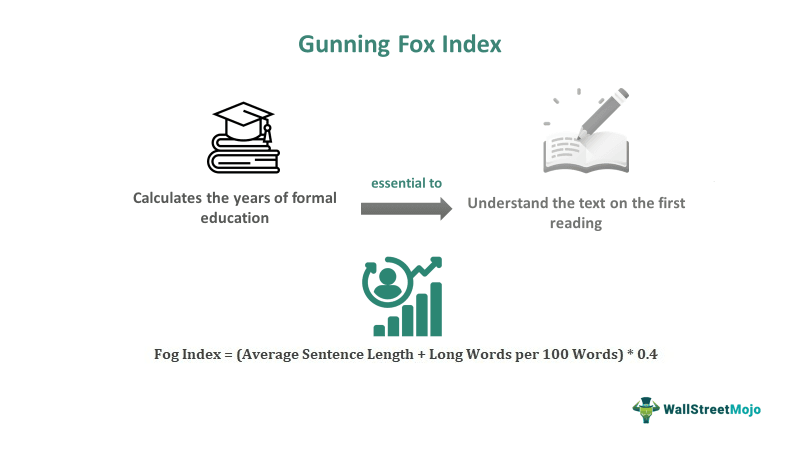Table Of Contents
Gunning Fog Index Meaning
The Fog Index, also known as the Gunning Fog Index, is a readability assessment tool designed to measure the complexity of written text. It assigns a grade between 0 and 20 to indicate the level of comprehension required to understand the text.

This tool enables writers to evaluate the readability of their writing and make adjustments for better reader understanding. It helps ensure that even complex concepts can be accessible to a wider audience. Texts are classified into different genres based on their accessibility scores. Skillful writers strike a balance between simplicity and complexity, creating content that is both engaging and informative.
Key Takeaways
- The Fog Index, commonly referred to as the Gunning Fog Index, evaluates the readability of text.
- It assigns a grade from 0 to 20 to indicate the complexity of written content, helping determine the required comprehension level.
- To calculate it, divide the total word count by the number of sentences, calculate the percentage of long words by multiplying the count of long words by 100, and then sum these components.
- While providing convenience, the index disregards essential factors like the reader's background, education, metaphors, and text length when assessing readability.
Gunning Fog Index Explained
The Gunning Fog Index is a readability metric that gauges the difficulty of written text by assigning it a specific grade. Created by Robert Gunning in 1952, the index aims to determine the ease of comprehension for readers. It addresses readability and comprehension challenges faced by readers when engaging with written material.
Furthermore, the index provides insight into the educational level required to understand and absorb a given text upon first reading. It quantifies the level of education a reader needs to comprehend an English text, considering factors such as the use of long words and sentence length. The index employs a formula to calculate a reader's grade level score based on their comprehension ability.
Lower scores indicate easier comprehension, while higher scores indicate greater complexity. Scores range from 0 to 20, reflecting the level of education necessary to grasp the text's content. For example, a score of 6 means that someone with a sixth-grade education can understand the text. Conversely, scores exceeding 17 suggest that a reader should have at least a graduate-level education to comprehend the text.
Formula
Robert Gunning proposed the Fog Index In 1952. The formula and calculation is straightforward.
Step 1: Compute Average Sentence Length
Average Sentence Length = Total Words / Sentences
Step 2: Count Words of Three or More Syllables
Long Words per 100 Words = Long Words / (Total Words / 100)
(Count the number of words of three or more syllables per each 100 words in the sample. Words that become three syllables with the addition of "ed" or "es" are not counted, nor are words that are capitalized or easy compound words)
Step 3: Calculate the Fog Index
Fog Index = (Average Sentence Length + Long Words per 100 Words) * 0.4
Examples
Let us use a few examples:
Example #1
Let's say you have a company's annual report with the following statistics:
- Total Words: 800
- Sentences: 15
- Long Words: 40
Compute Average Sentence Length
- Average Sentence Length = Total Words / Sentences
- = 800 / 15 ≈ 53.33
Count Words of Three or More Syllables
- Long Words per 100 Words = Long Words / (Total Words / 100)
- = 40 / (800 / 100) ≈ 5
Calculate the Fog Index
- Fog Index = (Average Sentence Length + Long Words per 100 Words) * 0.4
- = (53.33 + 5) * 0.4 ≈ 23.73
In this example, the calculated Fog Index is approximately 23.73. This score indicates a higher level of complexity and may be challenging for many readers.
Example #2
Imagine someone is reading financial news articles about different companies' stock performance. Some articles are easy to understand, while others use intricate language and long sentences. They can determine which articles are more reader-friendly using the Gunning Fog Index. If an article has a low index score, say 7, it suggests it's written in a clear and accessible manner. If it has a higher score, like 13, it may be more challenging for the average reader to comprehend the information about the stocks and the market fully.
Advantages And Disadvantages
The advantages & disadvantages are as follows:
Advantages
- One of the simplest methods for understanding and calculating readability.
- Provides quick metrics for measuring text readability.
- Effectively gauges the general readability of various types of texts.
- Facilitates aligning the audience's comprehension level with the complexity of the text.
- Enables easy comparison of readability among different texts.
- Even individuals with limited linguistic knowledge can utilize it.
- Widely acknowledged and employed in the publishing and education sectors.
Disadvantages
- Overlooks important factors such as the reader's background, education, use of metaphors, and text length when determining readability.
- Assessment doesn't account for complex sentence structures and language usage.
- Built-in bias is unsuitable for assessing language in artistic, technical, or scientific contexts.
- Readability isn't solely determined by sentence or word length, introducing subjectivity.
- The reader's familiarity with the topic and educational background significantly influence results.
- Emphasis on word length takes precedence over conveying content meaning.
- Fails to consider a writer’s intention in using complex language for persuasion or artistic expression.

